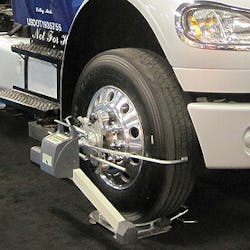Guest Blog: Let’s get it straight: Alignment for heavy duty rigs saves money
If you’re like many fleet managers, there’s one thing you might be overlooking that could save wear and tear on your vehicles and their drivers, not to mention save a lot of money on fuel costs—alignment.
At one point, alignment may not have made much sense. With the old-school method of using trammel bars and tape measures, you couldn’t get the kind of alignment accuracy that was going to make a huge dent in fuel costs. And it took so long, it wasn’t worth the effort of going through the process just to have it undone by the first pothole a driver hit.
But, all of that has changed. With modern heavy-duty alignment equipment you can set up and get alignment readings quickly.
You no longer need to calculate the benefits of taking a truck off the road for an alignment versus the benefits of keeping it rolling (and possibly wobbling) down the road without one. Instead of being seen as just an expense, you can now make a quantifiable impact on the overall bottom line in several ways.
A new heavy duty alignment system will help reduce:
Fuel costs. How much has your company spent in order to minimize fuel costs? From fuel optimization software to aftermarket contraptions meant to improve aerodynamics, many companies spend a lot of money to save a lot of money on fuel. But, alignment is one of the easiest ways to ensure a vehicle isn’t wasting a lot of energy—and fuel—fighting the physics of the road.
Tire costs. Along with fuel, tires are one of the biggest line items on a shop’s expenses. It goes without saying that aligned tires wear slower than tires that haven’t been aligned. But we’ll say it anyway: you can save thousands of dollars on tires and retreads every year by simply keeping tires aligned. By reducing rolling resistance, you increase tire life. It’s that simple.
Suspension stress. Misalignment stresses a truck’s suspension components, which makes the ride a lot less pleasant for the driver and results in costly suspension maintenance happening much more frequently.
Driver fatigue. Fighting the wheel can really wear drivers down. This can lead to poor decision-making that has dire consequences. You can’t control wind or weather—two factors that can make drivers struggle to keep everything moving forward. But, you can ensure that when the environment is pleasant, the driving is too.
One last thing about alignment: Don’t forget your trailers. Some shops only align the steer axle, but trailer alignment is essential for tire life. It’s recommended the trailers get aligned at least once a year.
Information provided by: Rotary Lift
